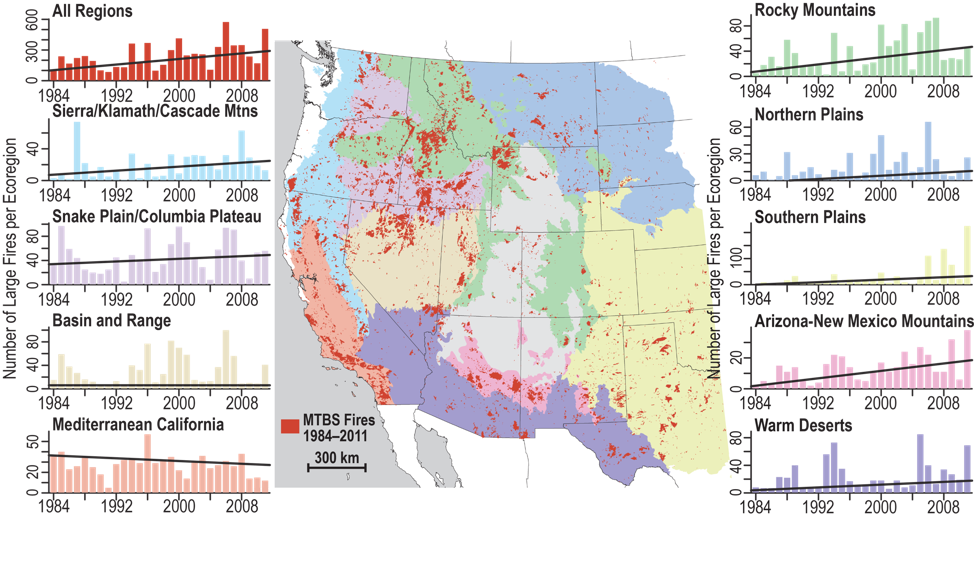In Large Wildfire Do Already Burned Lan Burn Again
Wildfires and Climate Change
Climate change has been a primal cistron in increasing the gamble and extent of wildfires in the Western United States. Wildfire risk depends on a number of factors, including temperature, soil moisture, and the presence of trees, shrubs, and other potential fuel. All these factors have potent direct or indirect ties to climate variability and climate change. Climate change enhances the drying of organic matter in forests (the material that burns and spreads wildfire), and has doubled the number of large fires between 1984 and 2015 in the western U.s..
Research shows that changes in climate create warmer, drier atmospheric condition. Increased drought, and a longer fire season are boosting these increases in wildfire run a risk. For much of the U.S. West, projections evidence that an average annual ane degree C temperature increase would increase the median burned area per twelvemonth as much every bit 600 percent in some types of forests. In the Southeastern United States modeling suggests increased fire risk and a longer fire season, with at least a 30 percent increase from 2011 in the area burned by lightning-ignited wildfire by 2060.
One time a fire starts—more than 80 percent of U.S. wildfires are caused by people—warmer temperatures and drier conditions can help fires spread and make them harder to put out. Warmer, drier conditions likewise contribute to the spread of the mountain pine beetle and other insects that tin can weaken or kill trees, edifice up the fuels in a forest.
Land use and wood direction also affect wildfire risk. Changes in climate add together to these factors and are expected to go along to increase the area affected by wildfires in the United States.
Trends in the almanac number of large fires in the western United States

Since 2000, 15 forest fires in the U.s.a. have caused at to the lowest degree $1 billion in damages each, mainly from the loss of homes and infrastructure, along with firefighting costs. The 2017 wildfire flavour was well above average, with mortiferous fires in California and throughout the West, including Montana, Oregon, and Washington country. The 2018 wildfire season went on to also break records equally the deadliest and most subversive season on tape in California. NOAA estimates the total costs of wildfires in 2017 and 2018 to exist more than than $forty billion. In 2019, wildfires caused an estimated $4.v billion in damages in California and Alaska. Alaska'south tape-breaking heat and dry out atmospheric condition over the summer months set the conditions for the state'due south historic wildfire season. In 2020, five of the vi largest fires on tape burned in California and Oregon saw celebrated levels of wildfire spread and damage. Wildfires across the West led to weeks-long periods of unhealthy air quality levels for millions of people.
Run across a map of billion-dollar extreme weather disasters hither.
- Wildfire tin can affect:
- Federal and State Budgets: U.Due south. Wood Service burn suppression expenditures had increased from virtually 15 percent of the agency's appropriated budget to more than l percent in 2017. Nationwide suppression costs in 2017 and 2018 ballooned to $2.nine billion and $3.one billion respectively, while land wildfire expenditures have also increased substantially.
- Public Wellness: The growing number of people in wild lands is increasing the risk to life, property and public health. Smoke reduces air quality and can cause eye and respiratory illness, especially among children and the elderly. Wildfires that fire in residential areas tin can cook plastic h2o pipes and cause contagion of water systems with a known carcinogen.
- Natural Environment: Wildfires are a natural part of many ecosystems. Although wildfires produce a number of greenhouse gases and aerosols including carbon dioxide, methane, and blackness carbon, the plants that re-colonize burned areas remove carbon from the atmosphere, by and large leading to a net neutral issue on climate. Withal, when fires burn more frequently and consume larger areas, equally they are doing with climatic change, the released greenhouse gases may non be completely removed from the atmosphere if plants can't grow to maturity earlier burning, or if the plants that re-colonize are less efficient at carbon uptake.
How to Build Resilience
- Communities, builders, homeowners, and forest managers can reduce the likelihood and impacts of wildfires past:
- Discouraging developments (especially residential) virtually fire-prone forests through smart zoning rules.
- Increasing the space between structures and nearby trees and brush, and immigration space between neighboring houses.
- Incorporating fire-resistant design features and materials in buildings.
- Increasing resources allocated to firefighting and fire prevention.
- Removing fuels, such equally dead trees, from forests that are at take a chance.
- Developing recovery plans earlier a burn down hits, and implementing plans chop-chop after a fire to reduce erosion, limit flooding, and minimize habitat harm.
For more details on wildfire resilience, read our study, Resilience Strategies for Wildfire.
Learn more than about resilience by visiting our Climate Resilience Portal.
Source: https://www.c2es.org/content/wildfires-and-climate-change/
0 Response to "In Large Wildfire Do Already Burned Lan Burn Again"
Post a Comment